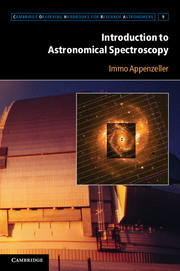Book contents
- Frontmatter
- Contents
- Preface
- 1 Historical Remarks
- 2 Spectroscopy in Present-Day Astronomy
- 3 Basic Physics of Spectral Measurements
- 4 Optical-Range Grating and Prism Spectrometers
- 5 Other Techniques for the Optical Spectral Range
- 6 Preparing and Reducing Optical Observations
- 7 UV, X-Ray, and Gamma Spectroscopy
- 8 Spectroscopy at Radio Wavelengths
- 9 Special Techniques of the FIR and Submillimeter Range
- 10 New Developments and Future Prospects
- Appendix: List of Acronyms
- References
- Index
3 - Basic Physics of Spectral Measurements
Published online by Cambridge University Press: 05 January 2013
- Frontmatter
- Contents
- Preface
- 1 Historical Remarks
- 2 Spectroscopy in Present-Day Astronomy
- 3 Basic Physics of Spectral Measurements
- 4 Optical-Range Grating and Prism Spectrometers
- 5 Other Techniques for the Optical Spectral Range
- 6 Preparing and Reducing Optical Observations
- 7 UV, X-Ray, and Gamma Spectroscopy
- 8 Spectroscopy at Radio Wavelengths
- 9 Special Techniques of the FIR and Submillimeter Range
- 10 New Developments and Future Prospects
- Appendix: List of Acronyms
- References
- Index
Summary
This chapter is devoted to the physical effects and methods that are available to measure electromagnetic flux as a function of its frequency or its wavelength. The content of the present chapter will form the basis for the following chapters, in which the technical realization and the practical use of these methods will be described.
In the literature, the term light is often reserved for radiation at visual or optical wavelengths. However, there exists no qualitative difference between the basic properties of electromagnetic waves of different frequencies. Therefore, in the following text, the shorter term “light” will be used for all types of electromagnetic radiation.
Electromagnetic Radiation
That light is composed of electromagnetic waves has been known since the nineteenth century. Along their paths these waves produce variations of an electric and a magnetic field, which are periodic in time and space. A complete treatment of the theory of electromagnetic waves can be found in the textbooks on electrodynamics and on optics. (For a concise introduction to the subject see, e.g., Chapter 2 of Wilson et al. (2009).) In the present chapter, some of the optical effects and important relations that are essential for practical spectroscopy will be summarized briefly.
Monochromatic Plane Waves
We first consider the special case of a monochromatic (or single-frequency) plane light wave propagating in a nonconducting medium in the positive x direction. Because the electric and magnetic fields are coupled, a light wave can be characterized by either its electric or its magnetic component. In the following text we discuss the electric field only.
- Type
- Chapter
- Information
- Introduction to Astronomical Spectroscopy , pp. 50 - 80Publisher: Cambridge University PressPrint publication year: 2012



